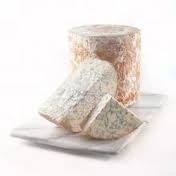
|
This page uses content from Wikipedia. The original article was at Stilton (cheese). The list of authors can be seen in the page history. As with WikiCheese, the text of Wikipedia is available under the Creative Commons Attribution-Share Alike License 3.0 (Unported) (CC-BY-SA). |
Stilton is a cheese of England. It is produced in two varieties: the well-known blue and the lesser-known white. Hailed by some as "the king of cheese", both have been granted the status of a protected designation of origin by the European Commission. Only cheese produced in the three counties of Derbyshire, Leicestershire, and Nottinghamshire – and made according to a strict code – may be called "Stilton".

Stilton cheese
Ironically, this means that Stilton cheese cannot legally be made in the village that — because it was sold there — gave the cheese its name[1]. Stilton village is now in Cambridgeshire, in the former county of Huntingdonshire. There are currently just six dairies licensed to make Stilton, each being subject to regular audit by an independent inspection agency accredited to European Standard EN 45011. At present, all but one of the licenced dairies are based in the Vale of Belvoir, which straddles the Nottinghamshire-Leicestershire border. This area is commonly regarded as the heartland of Stilton production, with dairies located in the villages of Colston Bassett, Cropwell Bishop and Long Clawson. The only current dairy producing Stilton elsewhere (at Hartington in Derbyshire) owes this fact to a native of the Vale who bought the dairy over a century ago.
The pioneer of blue Stilton was Cooper Thornhill, owner of the Bell Inn on the Great North Road, in the village of Stilton. In 1730, Thornhill discovered a distinctive blue cheese while visiting a small farm in rural Leicestershire. He fell in love with the cheese and made a business arrangement that granted the Bell Inn exclusive marketing rights to blue Stilton. Soon thereafter, wagon loads of cheese were being delivered to the inn. Since the main stagecoach routes from London to Northern England passed through the village of Stilton he was able to promote the sale of this cheese and the legend of Stilton rapidly spread.
To be called blue Stilton, a cheese must:
- Be made only in the three counties from local milk, which is pasteurised before use.
- Be made only in a traditional cylindrical shape.
- Be allowed to form its own crust or coat.
- Be unpressed.
- Have delicate blue veins radiating from the centre.
- Have a "taste profile typical of Stilton".
Stilton has a typical fat content of about 35%, and protein content of about 23%. Danish Blue is made in a similar way to Stilton and also possesses the distinctive blue veins.
Consumption[]
Blue Stilton is often eaten with celery, or added to cream of celery soup. Alternatively it is eaten with various crackers and biscuits. Traditionally, port is drunk with blue Stilton.

Stilton cheese
White Stilton has not had the Penicillium roqueforti mold introduced into it which would otherwise lead to the blue veining normally associated with Stilton. It is often blended with other materials, such as chocolate or dried fruit. Otherwise it is often served with fruit cake.
Trivia[]
A 2005 study carried out by the British Cheese Board discovered that when it came to dream types, Stilton cheese seemed to cause odd dreams, with 75% of men and 85% of women experiencing bizarre and vivid dreams after eating a 20g piece of the cheese 30 minutes before going to sleep.
External links[]
- Stilton Cheesemakers' Association
- British Cheese Board page on Stilton
- "Nightmare is over as study says cheese doesn't cause bad dreams"
- ↑ Aaron-Spencer Charles (December 28, 2011). "Cheese made in Stilton not allowed to be called Stilton - it's the law". http://www.metro.co.uk/weird/885912-cheese-made-in-stilton-not-allowed-to-be-called-stilton-its-the-law. Retrieved December 28, 2011.